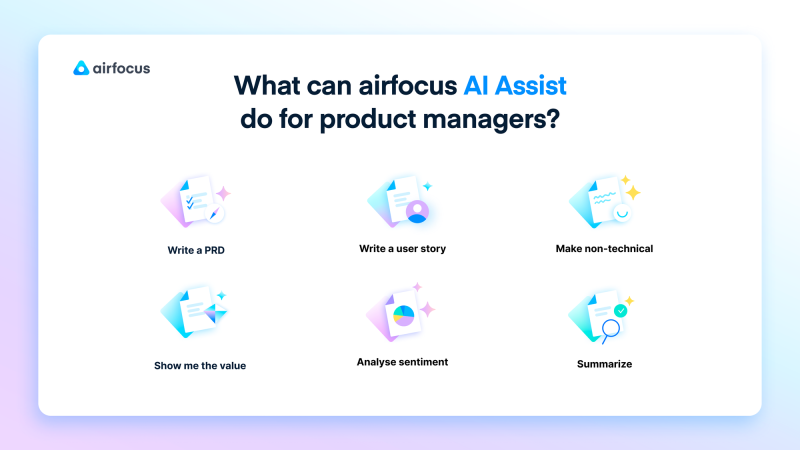Top 70 (+10 from airfolks) AI Prompts for Product Managers in Every Product Stage

Let's admit it, the thought of "what if I lose my job to AI?" has occurred to many (if not all) product managers at least once over the last period. With the boom of Generative AI applications like ChatGPT and the disruptions they are causing in every industry every single day, it's hard not to think about being replaced with a form of artificial intelligence.
But, product managers, there are ways to turn your greatest fear into your greatest strength!
Embracing AI as what it is now, an assistant, can be a game changer for your career, as it can help you do your everyday tasks more efficiently and streamline many of your processes. Think of AI as a wingman who can help free up more of your time to focus on the big picture; in other words, if used correctly, AI can be the "Goose" to your "Maverick", the "Sam" to your "Frodo" or the "Robin" to your "Batman".
But here is the big question, how can product managers use AI?
The possibilities are endless, you just have to use the right prompts. For example, you can use AI to help you during the different stages of product management, including discovery, planning, and development; it can help you with your strategy, prioritization, a release plan, or even with hiring the right product manager.
The key is knowing what prompts to use to get the best, and most helpful results.
This is why we have prepared for you, with the help of AI, a list of 70 prompts you can use in different stages of product management, to get the most help out of your new sidekick.
Start with, "I want you to act as a product manager and help me/tell me…"
Best AI prompts for product discovery
1. Generate product ideas based on customer and market needs and trends
2. Generate ideas for product features based on user feedback
3. Draft a product positioning statement
4. Conduct a SWOT analysis of the product
5. Generate a unique value proposition and market positioning for the product
6. Conducting user surveys and interviews to gather feedback
7. Carry out a market analysis for the category of the specific product
8. Identify customer pain points of the specific product
9. Create a product description
10. Suggest potential target markets for the specific product
11. Carry out a competitor analysis for products and features
12. Create user personas for the product
13. Run a customer satisfaction analysis of a product
14. Suggest potential upgrades to the product based on user and market needs
15. Generate user segmentation strategies based on user behavior
Best AI prompts for product planning
16. How to develop a product strategy that aligns with the company's vision, mission, and goals
17. How to create a product roadmap that aligns with the strategy
18. Draft a product vision statement
19. Conduct market and competitor research to inform product strategy and product roadmap
20. Generate a product roadmap
21. How to assess the potential for new products and ideas
22. Define the problem, customer needs, and pain points for the product
23. Define metrics, like KPIs, for measuring the success of the product
24. Pinpointing the risks associated with the product strategy and how to mitigate them
25. How to communicate and align with stakeholders and cross-functional teams on the product strategy and roadmap
26. Prioritize product backlog based on business goals and customer needs
27. Prioritize features based on data, feedback, and goals
28. Suggest OKRs for the product team
29. How to allocate product development resources based on prioritization
30. Evaluating and adjusting strategy based on feedback and changing trends in the market
31. How to balance short and long-term goals in the product strategy
32. How to report or present the progress and success of product strategy and roadmap
33. Evaluating if the product strategy is scalable and adaptable to changes over time
34. Managing stakeholders, and their expectations, and negotiating trade-offs in the product roadmap
35. How to stay up to date on trends and technology that can affect the product strategy
36. Balancing user needs, business goals, and technical restraints in the product strategy and roadmap
37. Generate a product launch plan
38. List user acquisition and retention strategies
39. Optimize release plan based on market and company priorities and trends
40. How to leverage AI to inform and improve my product strategy
Best AI prompts for product development
41. Write user stories
42. Build prototypes
43. How to make estimations about the product
44. Considerations for software architecture
45. Suggest product improvements based on feedback
46. How to do a retrospective
47. Suggest ideas for product documentation
48. Communicate with developers
49. Evaluating and choosing tools for product development
50. Test the product
51. How to ensure that the product follows the standards and regulations of the industry
Best AI prompts for product marketing
52. Create a marketing strategy for the product
53. Create a product pricing strategy considering target markets
54. Generate ideas for product demo videos
55. Suggest launch campaign ideas for the product
56. Write a press release for the product/feature release
57. Write a product launch email
58. Helping with the choice of the most suitable channels for product launch
59. Develop the content marketing strategy
60. Writing emails for a marketing campaign for the product
61. Crafting a social media marketing strategy
62. Suggest potential influencer marketers and strategies for influencer marketing
63. Suggest user loyalty programs
64. Suggest topics for content (blog posts, ebooks, webinars…etc) related to the product

Best AI prompts for your product team
65. How to hire the right product manager for this product/company
66. Developing a culture of innovation, improvement, and user-centricity in the product team
67. How to boost product team communication and collaboration
68. How to implement agile methodologies in the product team
69. Define roles and reporting lines in a product team
70. How to use AI to support the product team's growth and continuous learning
What AI prompts are the airfolks using?
Here at airfocus, we are naturally curious. We understand the value of AI and how it can help us with day-to-day tasks. Different teams use different prompts, and here are our top 10:
Write a brief for a writer about this topic
Describe an idea in a simplified way
Summarize an interesting article
Staying updated on market trends
Checking UX with a conversational approach
Autocompletion of keywords
Ideas for celebrating growth
Writing a poem about airfocus in the style of Eminem
Make this copy more simple, funnier, or shorter
Top product management memes

Conclusion
Embracing AI and making it work for you as a product manager is the best way to go if you want to work smarter, not harder. You can unlock the power of AI in product management with the new AI Assist by airfocus. Our new built-in super AI feature can help you with your PRD, problem statement, analyzing feedback sentiment, ideas for new features or even just writing faster. And it's all just a simple slash command away!
We recognize that AI is here to stay, and it is bound to affect how modern product managers go about their job in a multitude of ways that we are yet to witness. It is not here to replace product managers but help them, and with AI Assist, we aim to bring the best that AI has to offer, directly into our product management platform.

Nouran El-Behairy

Read also

Experience the new way of doing product management

Experience the new way of doing product management





